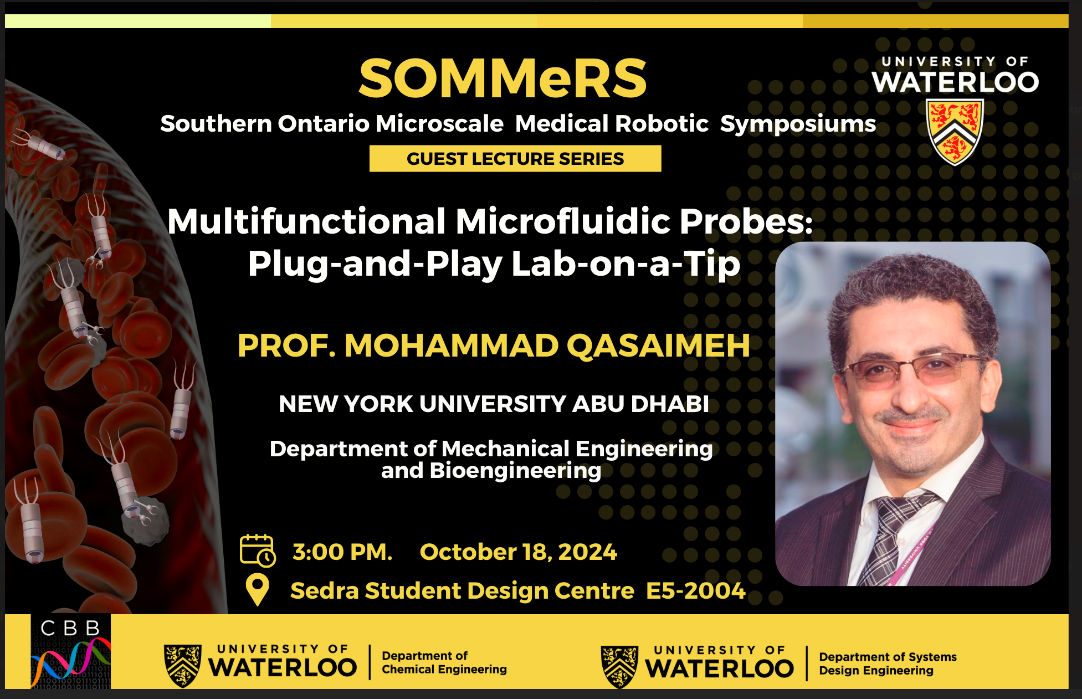Seminar Speaker Series

Biography
Biography:
Mohammad A. Qasaimeh is an Associate Professor of Mechanical Engineering and Bioengineering at New York University Abu Dhabi (NYUAD), Abu Dhabi, UAE, and a Global Network Associate Professor in the Mechanical and Aerospace Engineering and Biomedical Engineering departments at NYU Tandon School of Engineering. He is also the Associate Director of Faculty Scholarship Development at the NYUAD Center for Faculty Advancement. He received his PhD in Biomedical Engineering from McGill University in Montreal. During his PhD, he was awarded several prestigious fellowships and awards, including the NSERC Postdoctoral Fellowship and the Alexander Graham Bell Graduate Scholarship. Prior to joining NYUAD, he was a Postdoctoral Research Associate at the Massachusetts Institute of Technology and a Research Fellow at Harvard Medical School. Upon joining NYUAD, he established the Advanced Microfluidics and Microdevices Laboratory (AMMLab). His current research interests include developing microfluidic and MEMS devices for point-of-care diagnostics, surgery, and biomedical applications. Dr. Qasaimeh received the Distinguished Service Award from NYUAD in 2022 and the Technology Innovation Pioneers (TIP) Award from the UAE’s Ministry of Economy during the TIP 2020 Summit. His research has been published in several peer-reviewed journals, including Nature Communications, Small, Advanced Science, Advanced Materials Technologies, and Lab on a Chip, and he has delivered more than 45 keynote and invited lectures at national and international conferences. He is actively involved in organizing several local and international conferences and recently served as General Chair for the 6th International Conference on Manipulation, Automation and Robotics at Small Scales (MARSS). He currently serves as an Associate Editor for the journal Frontiers in Robotics and AI
(Nano- and Microrobotics), a Topic Editor for the journal Biosensors, a Review Editor for the journal Frontiers in Bioengineering and Biotechnology, and an Editorial Board Member for Scientific Reports at the Nature Publishing Group.
Abstract
In this research lecture, I will introduce the concept of Multifunctional Microfluidic Probes, cutting-edge tools designed for biomedical applications through a plug-and-play format. These probes are built upon microfluidic probe (MFP) technology, offering a "contact-less" approach to fluid handling that eliminates conventional microfluidic channels while hydrodynamically confining fluids. The result is a versatile platform that integrates microfluidics with scanning probe capabilities, allowing for precise targeting of biological samples outside channels, without disrupting surrounding regions, and enabling operation independent of physical substrates. The MFP concept can be envisioned as a Lab-on-a-Tip, in contrast to traditional 'closed-channel' microfluidics used in Lab-on-a-Chip systems.
Using 3D printing techniques, we are pushing the boundaries of MFP technology by developing integrated probes that combine multiple functionalities, including fluid mixing, bio-sampling, cell manipulation, and more. This talk will explore key biomedical innovations enabled by these probes, such as real-time cell separation and patterning, multiplex capture of circulating tumor cells, and single-cell biopsy sampling and analysis.
Additionally, I will showcase recent advancements in the development of a microfluidic mixing probe capable of generating controlled concentration gradients for drug testing on both adherent and suspended cells. Lastly, I will present the concept of modular, interchangeable probe heads, akin to a "LEGO-like" system, that can be easily adapted for various applications. This plug-and-play design is expected to democratize microfluidic technology, enhancing usability and functionality, and driving widespread adoption across biomedical fields.